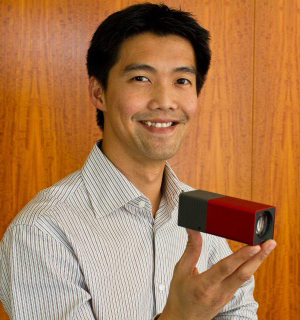Ren Ng Releases First Focus-Free Camera
By wchung | 23 May, 2025
Ren Ng Lytro is now taking orders for a lightfield camera that allows an image to be focused after a picture is snapped.
Ren Ng’s revolutionary Lytro lightfield camera captures light data to allow an image to be focused to any distance after a picture is snapped. It is available for order today and will start shipping next year.
The Lytro’s ease of operation is apparent from the fact that it has only two buttons — the power on/off button and the shutter release button.
The camera’s functioning is a bit more complex. The key is a glass layer patterned with 11 million tiny angled lenses placed atop a conventional digital camera sensor. The tiny lenses allow the sensor to record not only RGB color data but the precise angle of each pixel-producing ray. That angular pixel data allows Lytro’s software to apply an algorithm to generate an images focused to any focal length. In practical terms, it means that the user taps or clicks on any face or object on the image and bring it into focus.
Incidentally, the data manipulated by the Lytro camera also allows each image to be viewed in 3D format if desired.
“Refocusing the image becomes a new way to tell the story,” Ng says. “It injects a drama into the viewing moment, like when you discover a face that was out of focus in the background.”
The cost to capturing all that angular data is a loss of resolution. Each focused image from the Lytro can display about 640,000 pixels whereas a typical $200 digital camera, or even a smartphone camera, can display from about two to eight million pixels. Ng discounts the value of those lost pixels because most images are sampled down drastically before they are used. What’s more, the optics of most inexpensive digital cameras don’t really allow the capture of enough light information to support many millions of significant pixels, many claimed pixels being merely extrapolations.
Lytro’s real significance is the use of angular data to make pixels truly dynamic, opening the door to an entirely new way of combining the data processing capabilities of a computer with the light-capturing capabilities of a camera.
“It’s not just a consumer electronics company—it’s a Web 2.0 company as well,” says Ng, touting the Lytro online tools that allow users to share their lightfield images in a way that’s likely to generate considerable buzz.
Ng first focused on the concept of a lightfield (or plenoptics) camera while immersed in his PhD studies at Stanford. The interest grew into the 200-page PhD dissertation titled Digital Light Field Photography that he submitted in July 2006. The dissertation won the ACM Doctoral Dissertation Award for best thesis in computer science and engineering. It also won Stanford University’s Arthur Samuel Award for Best Ph.D. Dissertation.
The dissertation’s biggest fan proved to be Ng himself. He decided the work would form the basis for a venture to build and market a consumer plenoptics camera. On the strength of the dissertation, Ng attracted $80 million in venture funding for Lytro.
Ren Ng, 31, is an avid rock climber. He holds a PhD in computer science and a BS in mathematical and computational science from Stanford University. He is married and has a daughter.

Ren Ng's Lytro startup grew out of his 2006 200-page Stanford PhD dissertation on the science of plenoptics.
Articles
- Asian Americans Likely to Benefit from SALT Deduction in Trump Tax Bill
- The Secret Wellness World Hidden in Metropolitan Cities
- Dollar Slides As US Loses Safe-Haven Status Amid Trump Turmoil
- Trump Administration Makes Good on Threat to Illegally Send Asian Migrants to Africa
- AI Giants Throw Millions at Rare 10,000x AI Talent
Asian American Success Stories
- The 130 Most Inspiring Asian Americans of All Time
- 12 Most Brilliant Asian Americans
- Greatest Asian American War Heroes
- Asian American Digital Pioneers
- New Asian American Imagemakers
- Asian American Innovators
- The 20 Most Inspiring Asian Sports Stars
- 5 Most Daring Asian Americans
- Surprising Superstars
- TV’s Hottest Asians
- 100 Greatest Asian American Entrepreneurs
- Asian American Wonder Women
- Greatest Asian American Rags-to-Riches Stories
- Notable Asian American Professionals

